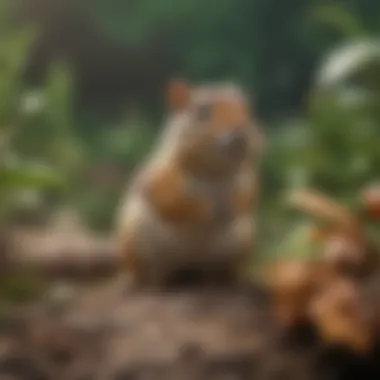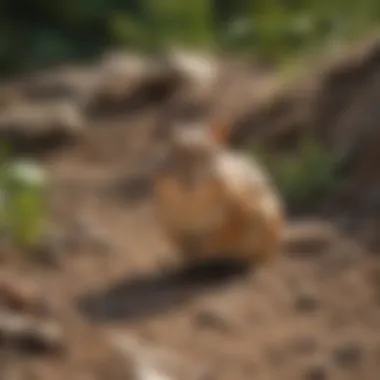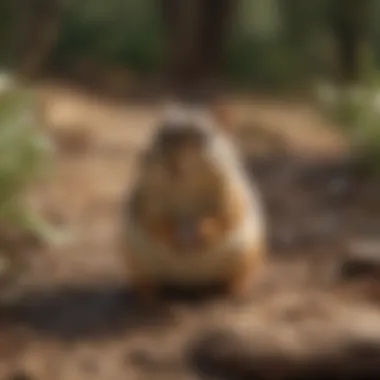Effective Strategies for Eliminating Chipmunks Around Your Home


Intro
Chipmunks can be charming little creatures, but their presence around homes can lead to significant challenges. Homeowners increasingly encounter these small mammals, often causing concerns about property damage and garden destruction. Understanding the behaviors and habitats of chipmunks is essential for preventing potential problems. This article aims to provide effective strategies tailored to maintaining a peaceful environment while respecting the natural behaviors of chipmunks.
Fascinating Facts About the Animal
Unique Characteristics
Chipmunks, belonging to the family Sciuridae, exhibit distinct features. They have small, slender bodies, usually measuring about 9 to 10 inches long, including their tails. Their fur displays a mixture of brown and gray, with characteristic stripe patterns along their backs. These stripes serve as camouflage in their natural habitats, helping them evade predators. Chipmunks also possess cheek pouches, allowing them to transport food back to their burrows for storage.
Extraordinary Abilities
Remarkably, chipmunks are skilled climbers. They can effortlessly navigate trees and shrubs thanks to their powerful limbs. Additionally, they are known for their agility, allowing them to swiftly escape danger. Their acute vision helps them detect any threats, while their keen sense of hearing alerts them to distant sounds that might indicate predator movement.
Behavior and Habitat
Natural Habitats
Chipmunks thrive in various environments, including forests, shrublands, and suburban areas. They prefer places with plenty of cover, such as bushes and tall grass, where they can easily hide from predators. Their burrows are typically located underground, providing shelter and safe spaces for nesting. Knowing their habits can aid homeowners in implementing effective control measures.
Social Structures
Chipmunks are generally solitary animals, although they may come together during the breeding season. Males and females will establish their territories, often overlapping slightly. Communication occurs through a series of chirps and chatters, signaling warnings or mating calls. Understanding their social structures can provide insights into their potential movements around residential areas.
Recent Scientific Discoveries
Latest Research Findings
Research on chipmunk behavior and ecology has advanced in recent years. Studies indicate that climate change is altering their habitat ranges, causing shifts in their population distributions. This emphasizes the need for homeowners to stay informed regarding environmental influences that can affect chipmunk activity.
Breakthroughs in Animal Biology
Interesting findings show that chipmunks can adapt their foraging strategies based on food availability. They exhibit various behaviors when resources are scarce, including increased movement to seek new food sources. These insights can help in developing effective management strategies for homeowners facing challenges with chipmunks.
Cultural Significance
Animals in Folklore
Chipmunks appear in various cultural narratives and folk stories. Often portrayed as clever and resourceful, they symbolize adaptability. Recognizing their role in human culture can foster a more respectful attitude towards their presence in our environments.
Influence on Art and Literature
In literature and art, chipmunks are often depicted as playful creatures, charming audiences of all ages. Their portrayal can lead to a deeper appreciation of wildlife and its intricate place in nature. Understanding this cultural significance can enrich one's perspective on wildlife management.
"Empathy towards wildlife leads to better coexistence strategies in shared environments."
Culmination
This section provided an overview of crucial information regarding chipmunks. Homeowners can benefit from understanding these animals better. The impending sections will delve more into specific effective strategies for managing chipmunks around homes.
Understanding Chipmunks
Understanding the biology and behavior of chipmunks is essential for homeowners facing challenges with these small mammals. Knowledge about chipmunks allows for more effective management strategies and helps in creating a conducive environment that respects wildlife. Recognizing their patterns enhances your ability to implement preventive measures and humane removal techniques effectively.
Biological Characteristics of Chipmunks


Physical attributes
Chipmunks are small rodents with a recognizable pattern of stripes down their backs. This distinct feature makes them easily identifiable. The average chipmunk weighs between 1 to 4 ounces and typically measures 8 to 10 inches in length, including the tail. These physical attributes enable them to navigate through diverse environments. For homeowners, knowing their size helps in assessing potential risks related to their presence.
Behavioral traits
Chipmunks are active during the daytime, making them diurnal. They exhibit fascinating behaviors such as hoarding food. This trait can be both advantageous and problematic. On one hand, it allows them to store resources for the winter; on the other hand, their burrowing behavior can lead to damage in gardens and lawn areas. Understanding these interactions is crucial for homeowners who wish to mitigate damage while still respecting wildlife.
Reproduction and lifespan
The typical lifespan of a chipmunk in the wild is around 2 to 3 years, but they can live longer in captivity. Chipmunks reach sexual maturity at about one year old, which is an important aspect to consider. They generally breed twice a year, leading to an increase in population if not managed properly. This rapid reproduction can exacerbate problems in gardens and yards, making understanding their reproductive patterns vital for effective control measures.
Habitat Preferences
Natural habitats
Chipmunks thrive in deciduous and mixed forests, where they find abundance of shelter and food. This is an important aspect of their ecological role. Their presence in these natural habitats keeps insect populations in check and contributes to seed dispersal, aiding forest regeneration. For homeowners, recognizing these habitats in proximity to their property can provide insights into potential interactions.
Adaptation to urban environments
In recent years, chipmunks have shown remarkable adaptability to urban settings. This adaptation is primarily due to the availability of food sources such as gardens and human refuse. While this can lead to an increase in chipmunk populations, it also poses challenges for homeowners who may face damage to gardens and structures. Understanding their urban adaptation assists in implementing effective deterrents to minimize conflicts.
Seasonal behavior patterns
Chipmunks exhibit distinct behavior changes with the seasons. During spring and summer, they are most active, foraging for food and preparing for winter. In autumn, chipmunks enter a hyperphagic phase, consuming large quantities of food for storage. Such seasonal patterns are crucial for homeowners. By recognizing these patterns, one can develop timely strategies for prevention and removal to mitigate potential damage from chipmunks during peak activity periods.
Problems Associated with Chipmunks
Chipmunks may seem cute, but they can be significant problem for homeowners. Understanding the issues they present is crucial for effective management. The presence of chipmunks affects not only gardens and landscaping but can also pose risks to homes and health. Addressing these challenges is essential to ensure a serene environment. Ignoring their impact may lead to larger issues, unmanageable problems, and possible contamination. This section will elaborate on the various problems associated with chipmunks, which are critical for determining solutions.
Agricultural Impact
Crops and gardens
Chipmunks can have a detrimental effect on crops and gardens. They feed on a variety of plants and can devastate vegetable patches, flower beds, and fruit trees. A notable characteristic of chipmunks is their foraging behavior. They are known to dig up seedlings and eat tender plants, which can disrupt a gardener's hard work. For homeowners, this means loss of both time and resources.
The unique aspect of their feeding habits is their capability to store food in burrows. This natural behavior can lead to significant depletion of available crops, affecting overall yield. If not addressed, the financial impact can grow each season.
Seed burrowing behavior
Seed burrowing behavior of chipmunks contributes to their status as pests. They frequently hoard seeds, nuts, and small fruits by creating underground storage. This characteristic makes them efficient in accessing food but problematic for gardeners and farmers who depend on maximum harvest.
Their seed-burrowing habit can lead to accelerated deterioration of seed availability in gardens and agricultural spaces. This behavior also creates visible disturbances in lawns and flower beds, often ruining aesthetic appeal. It is essential to understand this behavior to implement preventive measures effectively.
Home Damage Concerns
Nesting in structures
Chipmunks typically look for sheltered places to nest. This can lead them to invade homes and garages, causing various damages. They can create nests out of insulation materials found in attics, leading to increased repair costs. Their presence can also raise concerns about potential infestations of other pests, as nests may attract different species.
The notable aspect of nesting concerns is that these rodents do not require much space. They adapt well to small openings, making it easy for them to enter homes. Once they establish a nest, they can reproduce rapidly. This characteristic makes their control vital to avoiding a larger infestation.
Tunneling and burrowing effects
Tunneling and burrowing by chipmunks can create hidden structural issues. They dig extensive systems under trees, sidewalks, gardens, or even the foundation of houses. This can lead to weakening soil and potentially damaging structures over time. Homeowners may experience sinking or shifting foundations due to extensive burrowing.


A significant characteristic of tunneling is the disruption of tile drains or irrigation systems. Proper drainage is critical for landscaping and gardens. Chipmunk burrows can interfere and lead to flooding in heavy rains. Identifying these issues early can help minimize costly repairs and disruption.
Health Risks
Disease transmission
Chipmunks can pose health risks through disease transmission, which is an often overlooked aspect. They can serve as potential carriers for harmful pathogens, such as hantavirus and leptospirosis. Though the risk is low, it exists, especially in areas where chipmunks congregate. It is critical for homeowners to be aware of this factor.
The key aspect of these diseases is their potential to spread through droppings and urine. Encounters with infected chipmunks or their habitats can lead to exposure. Effective management can help reduce these risks and assure the health of residents.
Parasites and infestations
Chipmunks can also harbor parasites, contributing to further health concerns. Fleas, ticks, and mites can be carried into homes by chipmunks, posing additional risks to humans and pets. This characteristic makes it vital for homeowners to act quickly if chipmunks are detected. Once parasites establish themselves in a home, they can lead to extensive control measures, increasing costs and effort.
Understanding the potential for parasitic infestations can motivate homeowners to seek humane removal and preventive strategies proactively. By addressing these concerns swiftly, potential health issues can be avoided.
Understanding these issues is essential for developing an effective strategy to manage chipmunk populations and the complications they bring.
Humane Removal Techniques
Humane removal techniques play a crucial role in managing chipmunk populations around your home. These methods focus on preventing harm to these animals while addressing potential conflicts between humans and wildlife. It is important to approach chipmunk removal with sensitivity and care, following ethical practices and legal guidelines. The benefits of humane techniques include promoting biodiversity and creating a balanced ecosystem.
Identifying Chipmunk Activity
Signs of presence
Understanding the signs of chipmunk presence is essential. Common signs include burrowing activity, chewed vegetation, and droppings in your yard. recognizing these signs allows you to quickly assess if chipmunks are in the area. This proactive step is beneficial because it helps in timing interventions effectively. The unique feature of observing these signs is that it allows you to gather insight into the chipmunks' behavior, including their feeding habits. Knowing this can guide you in implementing effective preventive measures.
Monitoring methods
Monitoring methods are essential to keep track of chipmunk activity. These methods include visual observations, camera traps, and tracking the disturbances in your garden. This aspect is popular because it provides real-time data on chipmunk movements. A key characteristic of monitoring is its non-invasive nature, ensuring that chipmunks are not disturbed during the process. However, the disadvantage may be the time required to gather conclusive data, especially when using visual methods rather than cameras.
Trapping Methods
Live traps versus lethal traps
Choosing between live traps and lethal traps is a critical decision in chipmunk removal. Live traps capture chipmunks without harm, allowing for relocation. This method is beneficial as it supports humane treatment of wildlife, which aligns with ethical standards. The downside, however, is the responsibility of finding a proper relocation site. Lethal traps can be effective but raise ethical concerns and may not be suitable for all homeowners. This choice must align with your values and local regulations.
Best practices for trapping
Implementing best practices for trapping can greatly enhance your success. These practices include setting traps in areas of high activity, using appropriate bait, and checking traps regularly. The importance of following such practices lies in reducing stress to the chipmunks and increasing the likelihood of a successful capture. A unique feature of these best practices is their adaptability, as homeowners can modify their approach based on the observed behavior of the chipmunks. However, improper trapping techniques could lead to unintended harm, underscoring the need for careful planning.
Relocation Protocols
Choosing appropriate relocation sites
When relocating chipmunks, it is vital to choose appropriate sites. Suitable areas should offer habitat similar to their original home, such as forests or natural green spaces. This consideration is crucial because it increases the chances of the chipmunks surviving post-relocation. The unique feature here is ensuring that the relocated chipmunks can find adequate food and shelter. Not considering this can lead to high mortality rates in relocated animals, which raises ethical concerns.
Legal considerations
Legal considerations are important when removing and relocating wildlife. Many regions have specific laws regarding the treatment of wildlife. This awareness helps ensure compliance and avoids potential fines or legal issues. The key characteristic of these legal frameworks is to protect both homeowners and wildlife alike. However, the disadvantage is that navigating these laws can be complex and may require guidance from local wildlife agencies or professionals. Proper understanding protects both the person and the wildlife involved.
Preventive Measures
Preventive measures are crucial for maintaining a harmonious environment while addressing the challenges posed by chipmunks. By employing strategies that modify the habitat, utilize repellents, and establish ongoing monitoring, homeowners can significantly reduce the chances of chipmunks invading their properties. These methods not only address existing problems but also serve to deter future occurrences, ultimately fostering a sustainable approach to wildlife management.


Habitat Modification
Landscaping strategies
Landscaping strategies play a pivotal role in deterring chipmunks from encroaching on residential areas. By creating a less hospitable environment through design choices, homeowners can influence where these animals choose to inhabit. One key characteristic of effective landscaping is the elimination of dense foliage, which provides ideal cover for chipmunks. By opting for open spaces with minimal ground cover, the risk of attracting chipmunks declines.
The unique feature of this approach is its dual benefit; it not only helps in keeping chipmunks away but also enhances the aesthetic appeal of the garden or yard. However, a potential disadvantage includes the loss of habitat for other wildlife, which may affect local biodiversity.
Access denial
Access denial is another essential aspect of preventing chipmunks from making your property their home. This involves installing barriers, such as fences or wire mesh, around vulnerable areas. The key characteristic of this method is its proactive nature, blocking chipmunks from easily accessing spaces where they might otherwise burrow or nest. Implementing barriers made of materials that resist tunneling can effectively reduce intrusion.
One unique feature of access denial is that it can be customized according to the specific landscape of a property, making it a versatile option. Nonetheless, a disadvantage might be the initial effort and cost involved in setting up these barriers.
Repellents and Deterrents
Natural repellents
Natural repellents offer a sustainable approach to managing chipmunks without resorting to chemical solutions. Common substances such as cayenne pepper or citrus peels can be effective in repelling these creatures. The key characteristic of natural repellents is their non-toxic nature, making them a safe option for households with pets or children. These repellents tend to be popular due to their environmental friendliness.
A unique aspect of natural repellents is their ability to appeal to environmentally conscious homeowners. However, a disadvantage is that they often require frequent reapplication, particularly in adverse weather conditions, to maintain effectiveness.
Commercial products
Commercial products designed specifically for pest control can offer quick solutions for chipmunk management. These products often come in various forms, including sprays and granular formulas, which act as deterrents. The key feature of commercial repellents is their targeted effectiveness, often with proven success rates in urban environments. Such products are beneficial for those seeking immediate results.
However, the unique downside of commercial options may include potential health risks if misapplied and their impact on the local ecosystem. Additionally, some users might find this approach less appealing if they prefer non-synthetic alternatives.
Ongoing Monitoring
Regular inspections
Regular inspections are vital for assessing the integrity of preventive measures and ensuring that chipmunks do not establish a presence. Scheduling bi-weekly or monthly inspections allows homeowners to identify any signs of activity, such as burrowing or nesting. The key characteristic here lies in maintaining vigilance over time; this consistent awareness helps in timely addressing any intrusion.
The unique advantage of regular inspections is the opportunity for early intervention, which can prevent more extensive issues later on. However, a disadvantage may be the time commitment required to complete thorough checks.
Adjusting strategies as needed
Adjusting strategies as needed is critical for effective wildlife management. As conditions change, so do the behaviors of chipmunks. Addressing these changes is a key characteristic of a dynamic approach, ensuring that preventive measures remain effective. This may involve altering landscaping or changing repellents based on observed effectiveness.
The unique feature of this adaptability is the responsive nature to an ever-changing environment, allowing for refined management techniques. However, the drawback might be the confusion or inconvenience caused by frequently shifting strategies without clear results.
By integrating these preventive measures, homeowners can create an environment that respects local wildlife while effectively managing chipmunks.
Epilogue
In summarizing the significance of managing chipmunks around one's home, it is clear that an effective approach comprises understanding their behavior, recognizing potential dangers, and employing humane removal techniques. These strategies serve the dual purpose of safeguarding property while preserving the ecological balance. Homeowners who take proactive steps—such as modifying their landscapes or utilizing repellents—will likely see a reduction in chipmunk-related issues.
Summary of Key Strategies
To distill the many practical approaches discussed, here are the central strategies for effective chipmunk management:
- Habitat Modification: Adjust landscaping by trimming vegetation and removing food sources.
- Trapping: Use live traps for humane removal, understanding local regulations at all times.
- Use of Repellents: Apply both natural and commercial deterrents around areas at risk of invasion.
- Ongoing Monitoring: Regular inspections can help in early detection of chipmunk activity.
Implementing these measures creates a more pleasant living environment and reduces damage caused by these small mammals.
Encouragement for Responsible Wildlife Management
Responsible wildlife management is paramount for both the homeowner and the chipmunk population. Understanding that chipmunks are a crucial part of the ecosystem can lead to better coexistence. Homeowners are encouraged to approach the issue with a mindset geared towards sustainability. This involves not just elimination, but also considering the broader impacts our actions may have on wildlife.
Taking time to learn about the local wildlife can foster respect and appreciation. This, in turn, can lead to more informed decisions regarding pest control and habitat protection.
Fostering a healthy relationship with nature enriches our lives and contributes to a balanced ecosystem. Integrating humane practices into chipmunk management reflects not only a commitment to the home environment but also to the principles of conservation. Thus, maintaining an environment where humans and wildlife can thrive together should be the ultimate goal.







